PRISONS IN RUSSIA, A JOURNEY THROUGH TORTURE AND ABUSE
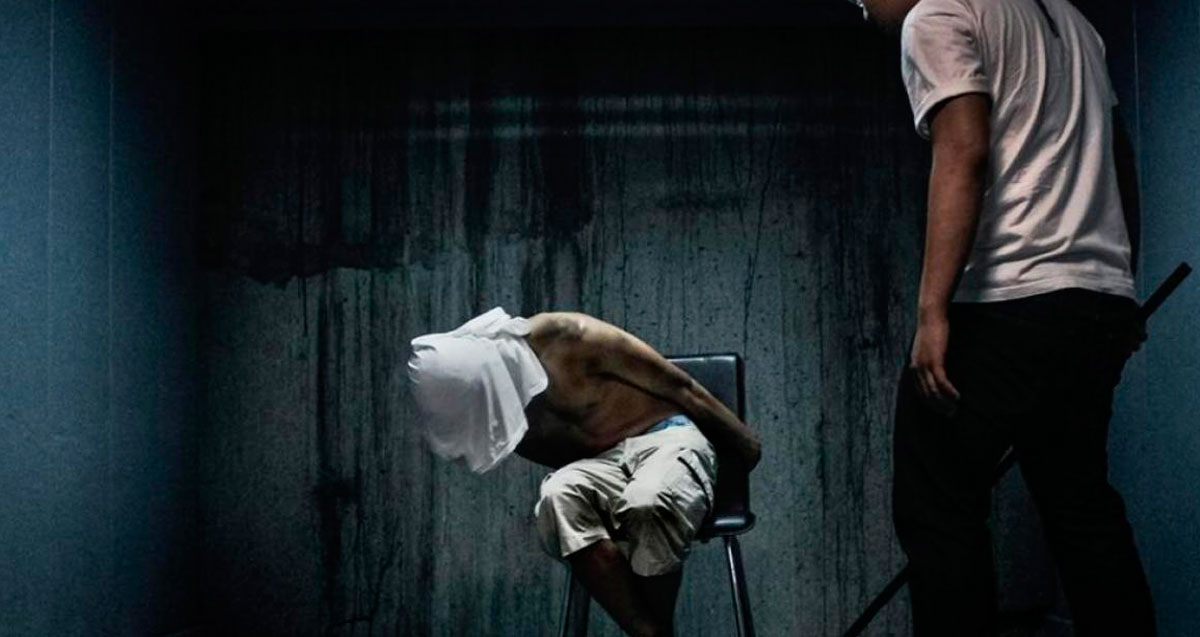
On February 16, 2024, Alexei Navalny, one of the most famous and important political opponents of Vladimir Putin, died inside the Siberian penal colony called IK-3, also known as “Polar Wolf”, a maximum security correctional facility located in town of Kharp, in the autonomous district of Yamalo-Nenets, a remote area of the Arctic Circle just under 2,000 kilometers from Moscow.
The first information provided by the prison facility on the dynamics of his death indicates that he “felt ill after a walk, losing consciousness almost immediately”. The family members, informed of the death and rushed to the facility, were given a diagnosis of sudden death syndrome, a very vague term which indicates a death caused by cardiac arrest but which does not specify the causes. Some sources report a death caused by a blood clot, information which is not very credible since to ascertain it would require an autopsy which, at the time of the events, could not yet have been carried out.
According to the newspaper Novaya Gazeta, the body, transferred to the morgue of the Salekhard district clinical hospital, shows signs of bruises compatible with some sort of convulsion and traces of attempts at cardiac massage. A special team of detectives promises to investigate while the family is denied the return of their remains.
On February 22, Lyudmila Navalnaya, Navalny’s mother, says that investigators allowed her to see the body of her son and made her sign a death certificate stating that her son died of natural causes[1].
The body will finally be returned and the funeral will be held on March 1st after numerous difficulties in finding a place that agrees to carry out the funeral. There will be thousands of people present and they will form long queues under the strict surveillance of hundreds of agents. Over a hundred people will be arrested during commemorations in honor of Navalny in at least nineteen cities[2].
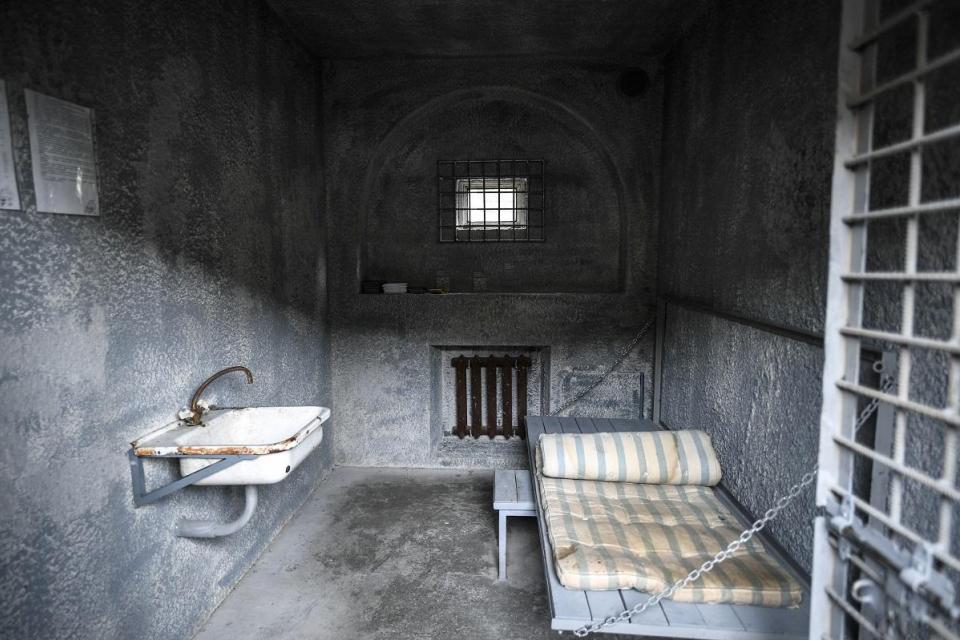
A reproduction of the cell in which Navalny was locked up in his last days of life is being set up in Paris[3]
A prisoner says that, the evening before the opponent’s death, a “strange confusion” erupted in the penal colony with the prison guards intensifying checks and strengthening security provisions. The following morning a “total requisition” operation was launched in the barracks, with the confiscation of cell phones and other personal objects from the prisoners; shortly thereafter, a committee from the central office of the Federal Penitentiary Service arrives and, around 8:00, the news of Navalny’s death spreads among the inmates.
After a political persecution that lasted for years – since 2012 he was the subject of a series of arrests, trials, short detentions and suspended sentences, in 2016 and 2017 he was beaten and sprayed with zelyonka, a green disinfectant, which is difficult to wash, with which it is usual to “brand” traitors – Navalny was arrested on January 17, 2021 while returning from Germany, after being treated for novichok poisoning. The activist knows that the Moscow court is waiting for him, but he deliberately chooses to meet his fate. In the trial on February 2 he received his first sentence of two and a half years for violating his parole and was locked up in the IK-2 penal colony in Pokrov province, about two hours’ drive east of Moscow, then transferred in June 2023 at the IK-6 facility in Melekhovo, Vladimir region[4].
But the prison regime reserved for the dissident will have to be even harsher and in December 2023 he is secretly taken to the IK-3 special regime facility, after three weeks of travel during which there is no news of him – from Vladimir to Moscow , then Chelyabinsk, Yekaterinburg, Kirov, Vorkuta, Kharp, an inhuman journey along a strange path as he himself will report, a practice reserved for prisoners deemed particularly dangerous[5].
In Kharp’s cell, Navalny will have to serve 19 years for violation of probation, embezzlement, contempt of court, reasons that smack of mockery: the real reason for the detention is obviously political. In 2023, in fact, another twenty years will be added for “terrorism” and “extremism”.
But not even in his cell does Navalny calm his opposition to the regime, despite the fact that a very harsh prison system is applied to him. The activist will accuse the Russian authorities of practicing torture: he is continuously woken up during the night, he is sent to the penalty cell three times in two months after having already undergone it 24 times in the previous penitentiary facility (out of 1,126 days he spends 295 in a shtrafnoy izolyator, or shizo, a very cold cell measuring 2 by 2.5 meters with a hole in the floor as a latrine and a bed that must be folded against the wall at 6 in the morning, so that the inmate is forced to stay all day standing[6]), he is monitored by a camera 24 hours a day, he is forced to go outside early in the morning and suffers freezing temperatures that reach -45° C, he is only given 10 minutes to eat his meals, he is almost completely isolated from his loved ones as he cannot have contact with the outside world or receive packages, they are denied medical care[7].
Sidereal distances from native lands: the psychological weapon
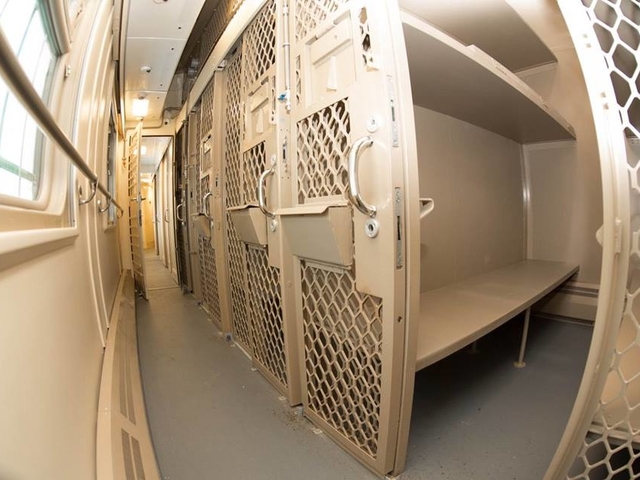
The interior of one of the armored cars, called “Stolypins”, used to transfer prisoners in inhumane conditions[8]
Russian law stipulates that prisoners must serve their sentences close to home to facilitate rehabilitation, yet most of them are moved thousands of kilometers away from their families. The remote locations in which the penal colonies are spread make family visits extremely difficult. Since only 46 of Russia’s 760 penal institutions accept women, it is the latter who are the biggest victims of inhumane prisons.
The practice of sending prisoners into exile in distant parts of the country is a tradition that dates back centuries to the Soviet period, becoming a unique penal culture in Russia that combines imprisonment with exile. Many of the 760 prisons belonging to the Soviet Gulag system and inherited from the Russian Federal Penitentiary Service (FSIN), are located in former labor camps in remote and sparsely populated parts of the country. To reach them, prisoners are forced to make long journeys that often last more than a month, carried out in inhumane conditions, crossing up to 6,000 km[9].
Heather McGill, a researcher who works for Amnesty International, talks about special carriages attached to normal convoys, with 3.5 square meter cabins in which up to 12 prisoners are crammed when at most they could hold four. The prisoners themselves must then carry their own belongings with them, there is no baggage convoy, which reduces the useful space even further. The compartments have no windows, only a grate overlooking the train corridor[10]. They are not provided with spare linen, they are not given the opportunity to wash for days, water is generally scarce and in those environments the temperature can reach 40°C. The toilet can be used every 6 hours, to the point that prisoners prefer not to eat or drink: a former prisoner states: “If I had known it the day before I would have stopped drinking: better to be thirsty than suffer on the train”[11].
Aleksei Sokolov of the Urals Human Rights Group reports that “distance is one of the ways to psychologically weaken prisoners. They are very far from support and help.” During transit the prisoners become invisible, there is no news of them for dozens of days, as in the case of Ildar Dadin, a political dissident who disappeared in December 2016 after claiming to have suffered torture and reappeared a month later in a prison colony near to Kazakhstan, 3,000 kilometers away from his previous prison[12]. Same fate for Navalny.
The penitentiary system, legacy of the Gulag
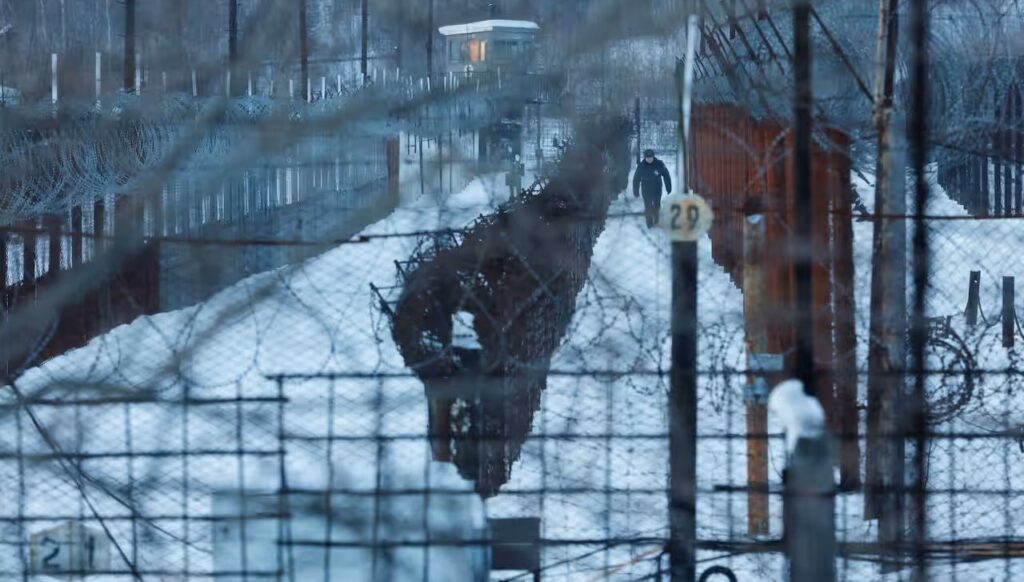
A glimpse of the IK-3 penal colony, known as Polar Wolf[13]
Escaping from these places is practically impossible and, if you succeed, you face certain death: high fences constantly monitored by guards equipped with dogs, around only desolation and hostile environmental conditions, with the nearest inhabited center which can even be several hundreds of kilometers.
The penal colony that saw Navalny’s death is one of the most hellish places of detention. Built in August 1961 and called YATs-34/3 (also known as Podgornaya) on the site of the 501st gulag, the structure became a camp for prisoners involved in the construction not only of the village, but also of the railway – according to the classic application of the Stalinist method -, construction sites where tens of thousands of prisoners die from hardship, beatings and accidents[14]. Renamed “OG-98/3 Institution” in 1999, the camp was transformed to house particularly dangerous and recidivist criminals and, since 2011, took the name of “FKU IK No. 3 UFSIN of Russia for the Yamal-Nenets Autonomous Okrug”[15].
Its occupancy limit is 1,100 inmates, and it is located on the outskirts of Kharp village, 45 km northeast of Salechard. It is a geographical area called the Polar Urals, 1920 km away from Moscow, surrounded by mountains, on the banks of the Sob river and within the Arctic Circle, the climatic conditions are therefore particularly harsh.
Reading the information on the IK-3 camp on the Penitentiary Portal, you would almost want to go there to spend the holidays, the inmates have everything: leisure, work, pay to use as you want, high-level education and professional training with the issuing of a diploma , excellent food, religious comfort, spaces for walks and meeting points, enchanting places, “open house” days where relatives and media representatives are welcomed; the only attention required is to stick to the rules, after all it is a prison with a special regime, discipline comes first so it can happen that someone gets beaten but, “you have to understand”, it is because they wanted it[16].
It is a pity, however, that the regime’s propaganda is not enough to cover the numerous complaints that, over the years, have emerged and which shine a spotlight on the real conditions of detention in places of punishment which often go beyond the boundaries of the most ferocious torture. Also thanks to Navalny and his lawyers who act as a bridge to make public the information, videos and details of that hellish place even by paying personally[17], , the world returns to talking about a reality that was never sufficiently known.
It emerges that the work is conceived in the same way as the Stalinist gulags, that is, in slavery: 12 hours a day which easily becomes 16/18 hours for a monthly payment of 300 rubles, or around 3.2 dollars, while a worker’s regular pay is over 19 thousand rubles[18]. Meals are meager and of poor quality, especially from a nutritional point of view, fruit and vegetables are a luxury: what allows prisoners to survive is the possibility of buying food or having it sent to them even if with great limitations, which however is not possible when you are punished[19].
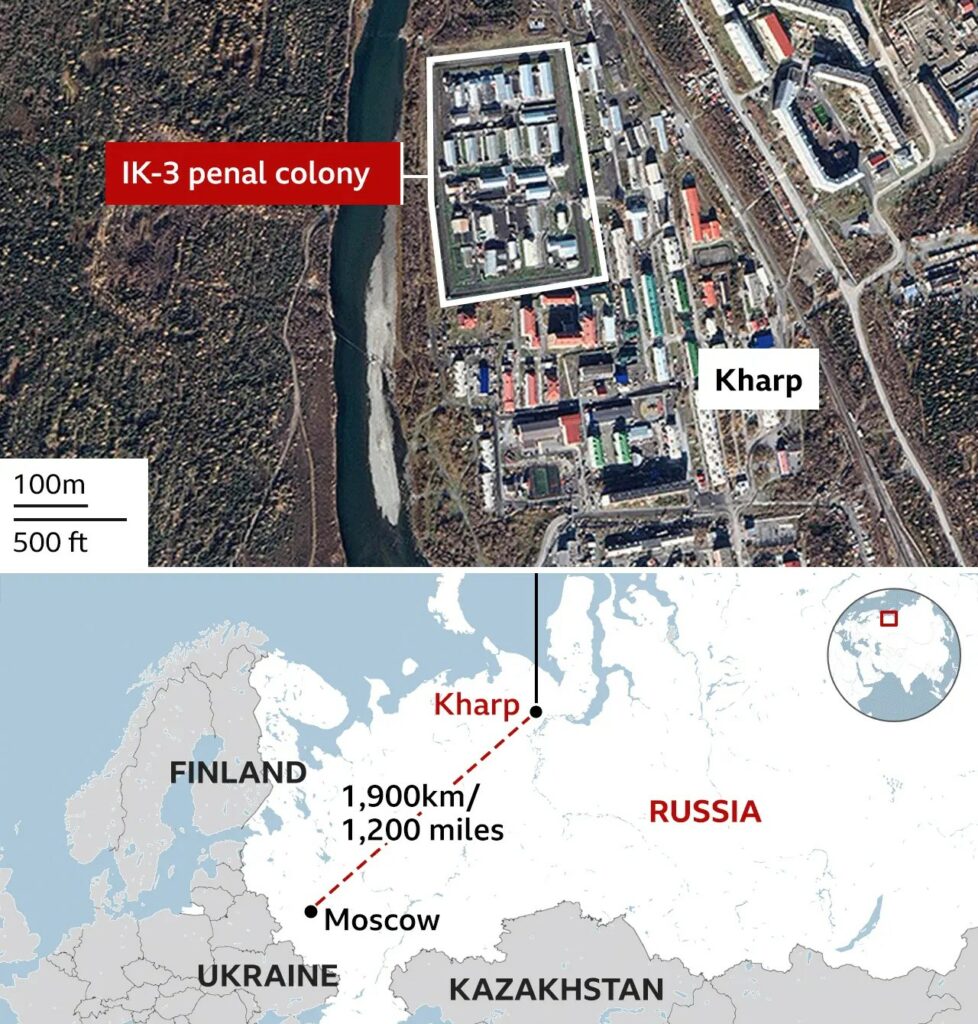
The IK-3 penal colony is located in a remote area in the Arctic Circle more than 1900 km from Moscow[20]
The rooms are cramped and overcrowded, people live in rooms packed with bunk beds with 60 men per room and there is a rigid regime that imposes menial and irrational tasks, such as cleaning and standing at attention for hours. Andrei Pivovarov, locked up for four years for political crimes, is forced to clean his solitary confinement cell for several hours a day and continuously listen to a recording of prison regulations. But he cannot stop to rest, for the guards who monitor him through the cameras it is an infringement of the rules that must be punished. In the first two years he managed to get only one hour and a half meeting with his mother and a few phone calls[21].
Healthcare is almost non-existent and the availability of basic medicines is practically nil. Prison guards, by definition, believe that the inmate who reports health problems does so to obtain some kind of privilege and therefore they do not listen to him[22].
The well-known American basketball champion, two-time Olympic gold medalist and nine-time WNBA All-Star Brittney Griner, is arrested on February 17, 2022 at the Sheremetyevo international airport in Khimki, after the authorities find a container with cannabis oil in the his baggage. She was sentenced to nine years in prison and was transferred to the IK-2 penal colony in Mordovia, over 300 miles from Moscow. On December 8, 2022, thanks to a prisoner exchange agreement, she is released in exchange for Russian arms dealer Viktor Bout.
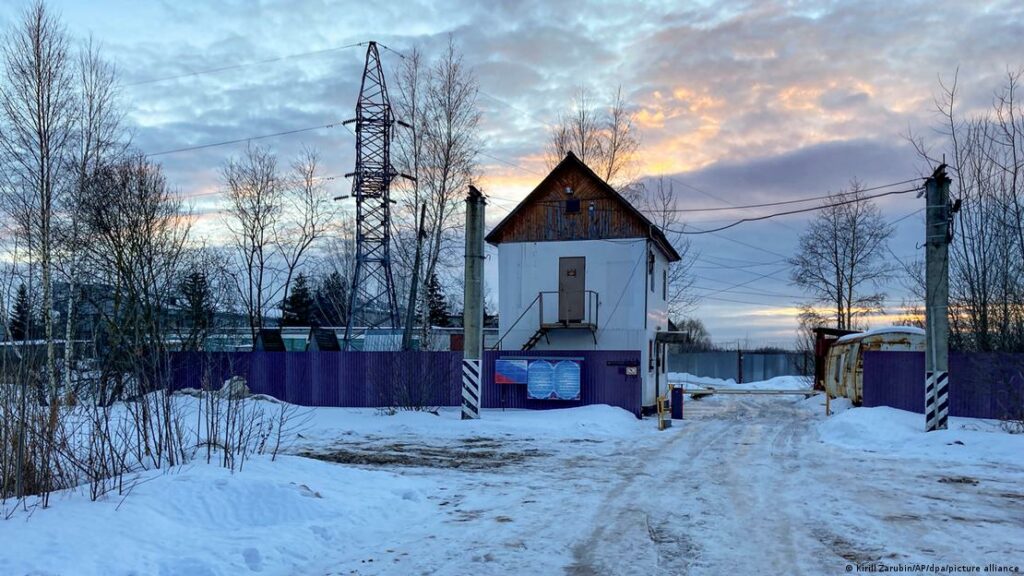
The IK-2 penal colony, east of Moscow, where the US basketball champion Brittney Griner was imprisoned[23]
Brittney Griner will talk about the terrible conditions to which she was subjected during the ten months of detention: the hygienic conditions are precarious, a roll of toilet paper must last a month, the tube of toothpaste expired 15 years before. She is given a mattress with a large blood stain on it, she has only two sheets with her, the climate is freezing and her cell is populated with spiders. She cuts fabric for military uniforms and works in brutal conditions for long hours with no chance to rest[24].
Zoya Svetova, a journalist and prisoner’s rights advocate, explains that such conditions are made possible because, although prisons are technically overseen by commissions that carry out inspections and defend prisoners, their members have been replaced by government loyalists in recent years[25].
In prisons, torture is widespread and known to all
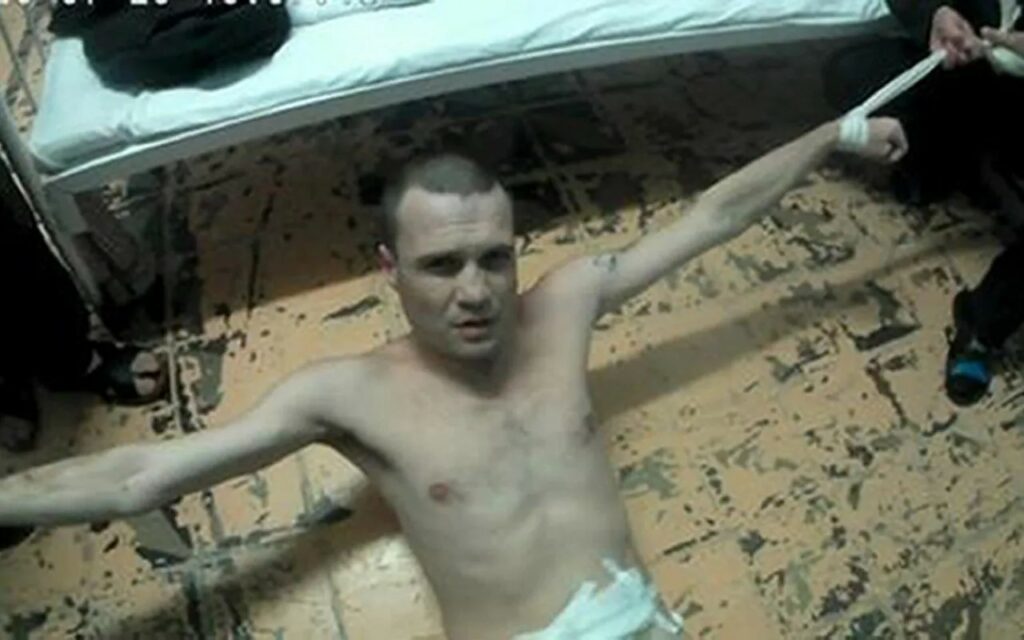
One of the prisoners in a Russian penal colony subjected to torture: the video is published by the NGO Gulag.net[26]
In Russia it is easy to end up in prison: the incarceration rate is currently 300 people per 100 thousand, a sharp decrease compared to previous years – in 2018 it was 416 – but it still remains a high figure, considering that the European state with the highest Incarceration rate is Poland with 197 people per 100 thousand[27]. Furthermore, in Russia the average sentences are four times higher than in European countries[28]. Detention for political or religious reasons deserves particular mention: the human rights group Memorial indicates 628 people convicted of political crimes, including more than 400 persecuted for their religion[29]. According to OVD-Info, 1,132 people are in prison for political reasons in Russia[30].
According to official data, the prison population is in sharp decline: Russia is proud to have halved its prison population in the last twenty years, going from over one million at the beginning of the century to 433,000 on January 1, 2023. Too bad that the data is released by the same FSIN which has the task of showing the world a direction towards a more humane prison system, and the data itself is easily manipulated and therefore not very credible[31]. Furthermore, among the reasons for the drastic decrease there would be the enlistment of around 100 thousand prisoners in the war in Ukraine [32], but how many of them were recruited by Wagner, for example, is a fact that must remain secret [33]: it is estimated that there are tens of thousands, perhaps 50 thousand, sent into the bloodiest battles [34], prisoners are promised amnesty, a clean criminal record and the possibility of returning home after at least six months of fighting, even if they have committed violent crimes such as murder or rape[35].
In several cases, however, once they arrived from the front and were freed, the prisoners returned to commit the same crimes for which they had been convicted. Thanks to the controversy that arose, in September 2023 Putin issued a decree that drastically changed the agreements, tightening them: the “contract” stipulated with the army now provides for a duration of one year, but in reality if the war is not over it will be extended automatic. With the new rules, a prisoner will be able to obtain rehabilitation only if he gets a decoration, a disability, if he reaches the age limit or if the war ends[36].
What most characterizes Soviet prisons is the failure to respect the minimum guarantee conditions: the regime inside the cells is often harsh, dehumanizing and borders too easily on torture practices. Oleg Kozlovksy, a researcher at Amnesty International, says that, despite being reformed, Russian prisons “still more or less retain the backbone of the Soviet system”[37]. The FSIN itself declares that between 1,400 and 2,000 deaths per year occur in the prison environment, the main cause is attributed to heart problems, a diagnosis that applies to almost everything and which is also used to cover up murders and suicides[38].
The first major scandal over prison conditions broke out in 2018: Novaya Gazeta made public a 10-minute video received from the NGO Public Verdict in which several acts of torture against prisoners – including Yevgeny Makarov, Ivan Nepomnyashchikh and Ruslan Vakhapov – were documented by part of the prison guards. The prisoners, immobilized, are repeatedly hit with truncheons on the legs and heels amidst cries, screams and pleas[39].
Torture, used against prisoners in custody and sentenced to imprisonment both by their cellmates and by officials and employees of the Federal Penitentiary Service of the Russian Federation, is a practice known to all and the State, in its intentions, shows itself interested in dealing with the problem.
In the same year, the Attorney General’s Office opened 20 criminal proceedings against employees of the federal penitentiary service regarding the use of “illegal methods” such as force and “special means”, the crime being abuse of office. The same Prosecutor sends two resolutions to the head of the FSIN Gennady Kornienko, condemning the increase in the number of violations of individual rights, the embezzlement of funds allocated for the improvement of penal institutions and other abuses, and promises investigations also against colluding officials[40].
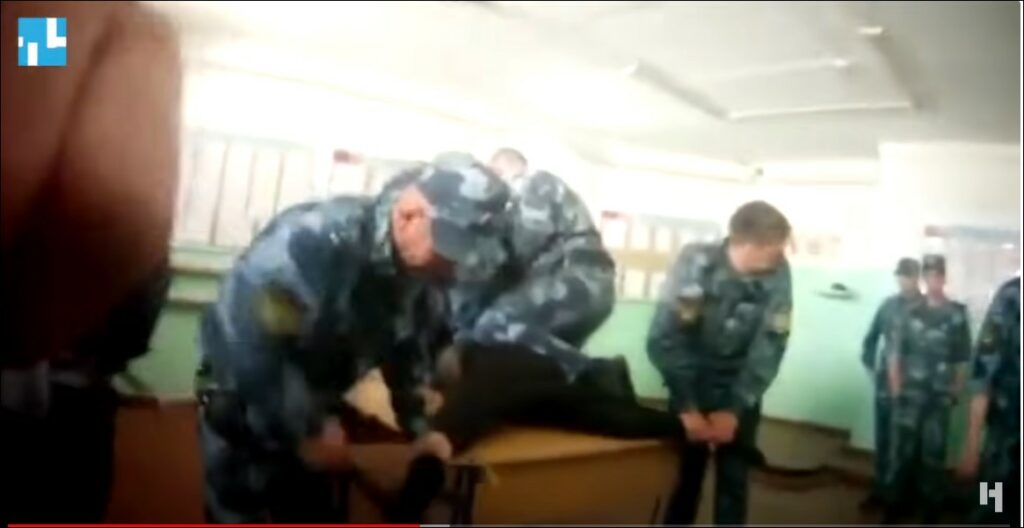
In 2018, a 10-minute video was released showing some inmates being brutally beaten by their jailers[41]
In the wake of the issue, the Council chaired by the Russian Federation for the Development of Civil Society and Human Rights prepares its recommendations to be addressed to some relevant departments, in particular the Ministry of Justice, the Federal Penitentiary Service, the Ministry of Internal Affairs , Ministry of Health and Ministry of Labour[42]. The responses from the departments are not long in coming: it is fine to welcome suggestions on the adoption of small changes, such as the abolition of restrictions on telephone conversations, while on the more demanding resolutions the rejection is clear. The reason given is the excessive economic commitment necessary for implementation, 5 billion rubles, considered unsustainable[43]. In practice nothing is done.
Meanwhile, complaints follow one another and come from practically all the penitentiaries.
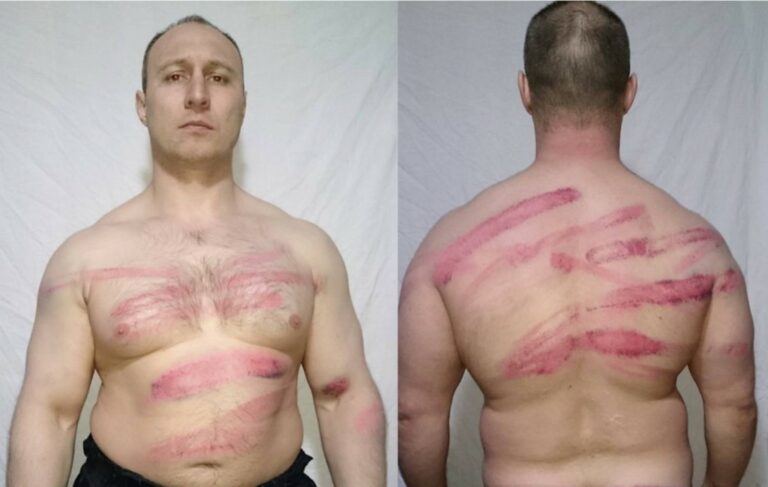
The prisoner Vitaliy Buntov, tortured in the IK-1 colony in the Tula province, reported the abuse in 2010 and in 2012 obtained compensation of over 55 thousand euros[44]
Sergey Savelyev, 32 years old, Belarusian, sentenced in 2013 to seven and a half years for drug trafficking, was imprisoned in the Penitentiary Hospital No. 1 of the Saratov penal colony, 800 kilometers southeast of Moscow. Released in 2021, he handed over to Gulagu.net, the Russian human rights group[45] founded by activist Vladimir Osechkin, an electronic device containing a large amount of material including hundreds of videos documenting torture and abuse, especially sexual, against detainees. He managed to obtain the files while working within the prison as an IT maintenance worker[46].
The incredible amount of material provided unequivocally documents the systematic use of torture. Listed by the government as wanted for “disclosure of state secrets” and threatened with death, Savelyev was forced to flee Russia and seek refuge in a secret location in France[47]. He tells his story: “They beat me, tortured me for months, with water and electricity. I wanted to die.” Often, other detainees, acting on the orders of the guards, torture the prisoners, thus allowing the agents to remain unpunished: “They form squads of inmates who obey everything; many have been tortured and humiliated and have become dehumanized; they are also victims of the system. There are many cases of suicide[48].
According to numerous testimonies, the prison system is designed to break the human spirit, aiming at psychological isolation and forcing detainees to depend for their survival on total and unconditional obedience to the will of the prison guards, the only possible but deceitful point of reference: your life is literally in their hands; they can save it or take it away, or make it horrendously complicated.
The United Kingdom, immediately after Navalny’s death, sanctioned six officials of the Arctic penal colony where the Russian opposition leader was detained and killed: they will be banned from the UK and their assets will be frozen, according to the Foreign Secretary. Among those sanctioned is Vadim Konstantinovich Kalinin, who supervised the IK-3 prison. The others sanctioned are: Lieutenant Colonel Sergey Nikolaevich Korzhov, Lieutenant Colonel Vasily Alexandrovich Vydrin, Lieutenant Colonel Vladimir Ivanovich Pilipchik, Lieutenant Colonel Aleksandr Vladimirovich Golyakov, and Colonel Aleksandr Valerievich Obraztsov, all deputy chiefs within the IK-3 structure[49].
However, Western condemnations are likely to remain mere statements of intent, as little or nothing can be done against a despotic and disrespectful human rights culture that permeates the current regime.
RUS042
[1] https://abc7news.com/how-did-alexey-navalny-die-death-certificate-mother-lyudmila-navalnaya/14457068/
[2] https://www.france24.com/en/live-news/20240302-navalny-s-mother-visits-son-s-grave-after-funeral-draws-thousands
[3] https://timesofmalta.com/article/like-animal-replica-navalnys-cell-set-paris.1019304
[4] https://www.ilfattoquotidiano.it/2022/07/02/alexei-navalny-racconta-su-twitter-la-sua-routine-in-carcere-ore-su-una-panca-di-legno-a-fissare-il-ritratto-di-putin/6647594/
[5] https://www.amnesty.org/en/latest/press-release/2017/10/russia-prisoner-transport-conditions-evoke-gulag-era-legacy/
[6] https://www.sbs.com.au/news/article/punishment-cells-freezing-conditions-and-torture-alexei-navalnys-harrowing-time-in-jail/zbo4patx0 ; https://www.theguardian.com/world/2024/feb/23/the-last-days-of-alexei-navalny-russia-prison
[7] https://www.gov.uk/government/news/uk-sanctions-heads-of-arctic-penal-colony-where-alexei-navalny-was-killed
[8] https://www.amnesty.org/en/latest/press-release/2017/10/russia-prisoner-transport-conditions-evoke-gulag-era-legacy/
[9] https://www.penalreform.org/blog/prisoner-transportation-in-russia-travelling-into-the-unknown/
[10] https://www.penalreform.org/blog/prisoner-transportation-in-russia-travelling-into-the-unknown/
[11] https://www.amnesty.org/en/latest/press-release/2017/10/russia-prisoner-transport-conditions-evoke-gulag-era-legacy/
[12] https://www.amnesty.org/en/latest/press-release/2016/11/russia-shocking-new-torture-allegations-by-prisoner-of-conscience-must-be-investigated/
[13] https://www.theguardian.com/world/2024/feb/23/the-last-days-of-alexei-navalny-russia-prison
[14] https://prisonlife.ru/mesta-lishenya-svobodi/1207-ispravitelnaya-koloniya-3-pos.-harp-yamalo-neneckiy-avtonomnyy-okrug.html
[15] https://ria.ru/20051014/41776152.html
[16] https://prisonlife.ru/mesta-lishenya-svobodi/1207-ispravitelnaya-koloniya-3-pos.-harp-yamalo-neneckiy-avtonomnyy-okrug.html
[17] https://apnews.com/article/russia-crackdown-kremlin-prison-navalny-1917e46e12ad2619d96c7aac06b20e24
[18] https://apnews.com/article/russia-crackdown-prison-navalny-karamurza-putin-3e5b9f5d3cfde3256819fbde5e405067
[19] https://apnews.com/article/russia-crackdown-prison-navalny-karamurza-putin-3e5b9f5d3cfde3256819fbde5e405067
[20] https://www.bbc.com/news/world-europe-68322113
[21] https://www.rferl.org/a/russia-pivovarov-penal-colony-disappearance/32279318.html
[22] https://apnews.com/article/russia-crackdown-prison-navalny-karamurza-putin-3e5b9f5d3cfde3256819fbde5e405067
[23] https://www.dw.com/en/alexei-navalny-describes-harsh-conditions-in-russian-penal-colony/a-56910497
[24] https://eu.usatoday.com/story/sports/wnba/2024/05/01/brittney-griner-conditions-russian-prison-penal-colony/73527381007/
[25] https://apnews.com/article/russia-crackdown-prison-navalny-karamurza-putin-3e5b9f5d3cfde3256819fbde5e405067
[26] https://www.ibtimes.sg/putins-horrifying-new-prison-torture-videos-show-how-inmates-are-raped-mutilated-photos-61239
[27] https://worldpopulationreview.com/country-rankings/incarceration-rates-by-country
[28] https://lespresso.it/c/mondo/2022/9/11/le-carceri-russe-di-oggi-sono-come-i-gulag-ecco-linferno-in-cui-e-rinchiuso-alexei-navalny/25115
[29] https://memopzk.org/list-persecuted/spisok-politzaklyuchyonnyh-bez-presleduemyh-za-religiyu/
[30] https://en.ovdinfo.org/data-politically-motivated-criminal-prosecutions-russia
[31] https://ridl.io/lies-damn-lies-and-statistics-how-many-prisoners-has-wagner-really-recruited/
[32] https://www.washingtonpost.com/world/2023/10/26/russia-prison-population-convicts-war/
[33] https://ridl.io/lies-damn-lies-and-statistics-how-many-prisoners-has-wagner-really-recruited/
[34] https://www.rferl.org/a/russia-prison-system-interview-olga-romanova/32614416.html
[35] https://www.bbc.com/news/world-europe-68140873
[36] https://www.bbc.com/news/world-europe-68140873
[37] https://apnews.com/article/russia-crackdown-prison-navalny-karamurza-putin-3e5b9f5d3cfde3256819fbde5e405067
[38] https://www.bbc.com/news/world-europe-68322113
[39] https://www.ibtimes.sg/putins-horrifying-new-prison-torture-videos-show-how-inmates-are-raped-mutilated-photos-61239
[40] https://www.interfax.ru/russia/631470
[41] https://www.youtube.com/watch?v=Q6QYXvbkkws&rco=1
[42] http://www.president-sovet.ru/files/46/cd/46cd0515cc4b6320f23943011bbcbe50.pdf
[43] https://www.advo24.ru/publication/pytki-v-tyurmakh-poyavitsya-li-statya-v-uk-rf.html
[44] https://en.odfoundation.eu/a/8048,the-case-of-vitaliy-buntov-a-prisoner-who-won-his-case-against-russia-at-the-echr-continues-to-be-subjected-to-torture/
[46] https://www.theguardian.com/world/2021/nov/08/i-was-always-scared-inmate-who-exposed-systemic-russian-prisoner-abuse
[47] https://today.rtl.lu/news/world/a/1806287.html
[48] https://www.theguardian.com/world/2021/nov/08/i-was-always-scared-inmate-who-exposed-systemic-russian-prisoner-abuse
[49] https://www.gov.uk/government/news/uk-sanctions-heads-of-arctic-penal-colony-where-alexei-navalny-was-killed

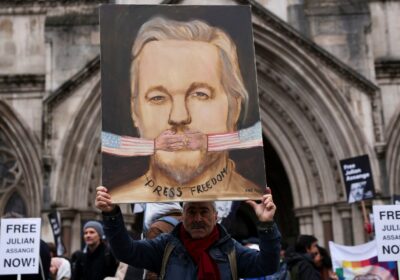


Leave a Reply